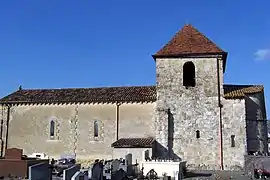Sauveterre-de-Guyenne
Sauveterre-de-Guyenne (French pronunciation: [sɔvətɛʁ də ɡɥijɛn], literally Sauveterre of Guyenne; Gascon: Sauvatèrra de Guiana) is a commune in the Gironde department in Nouvelle-Aquitaine in southwestern France.
Sauveterre-de-Guyenne | |
|---|---|
 The church of Saint-Romain-de-Vignague in Sauveterre-de-Guyenne | |
.svg.png.webp) Coat of arms | |
Location of Sauveterre-de-Guyenne | |
 Sauveterre-de-Guyenne  Sauveterre-de-Guyenne | |
| Coordinates: 44°41′37″N 0°05′06″W | |
| Country | France |
| Region | Nouvelle-Aquitaine |
| Department | Gironde |
| Arrondissement | Langon |
| Canton | Le Réolais et Les Bastides |
| Intercommunality | CC rurales de l'Entre-Deux-Mers |
| Government | |
| • Mayor (2020–2026) | Christophe Miqueu[1] |
| Area 1 | 31.75 km2 (12.26 sq mi) |
| Population | 1,858 |
| • Density | 59/km2 (150/sq mi) |
| Time zone | UTC+01:00 (CET) |
| • Summer (DST) | UTC+02:00 (CEST) |
| INSEE/Postal code | 33506 /33540 |
| Elevation | 38–107 m (125–351 ft) (avg. 82 m or 269 ft) |
| 1 French Land Register data, which excludes lakes, ponds, glaciers > 1 km2 (0.386 sq mi or 247 acres) and river estuaries. | |
Toponymy
Before 1896, Sauveterre-de-Guyenne was better known as Sauveterre-de Bazadais. This Bastide was built in a small village called "Athala" and was first named Salva-Terra (Salvation of the land), which later became Saubeterre and then Sauveterre.
History
Sauveterre-de-Guyenne was founded as an English Bastide in 1281 by King Edward I of England, in the name of ending rivalries among the lords. He signed the "Charte des Coutumes de la Cité" in 1283, which protected the inhabitants and set the rules of life in the village community.
Structure
Sauveterre-de-Guyenne is a very well maintained Bastide, having the typical Bastide 'grid' layout.[3] The entry points into the city were through four stone tower gates. The central market square is surrounded by stone houses and the typical arcades on the ground floor, full of shops. The Church of Notre Dame is located at the top of the square.
Population
|
| ||||||||||||||||||||||||||||||||||||||||||||||||||||||||||||||||||||||||||||||||||||||||||||||||||||||||||||||||||
| Source: EHESS[4] and INSEE[5] | |||||||||||||||||||||||||||||||||||||||||||||||||||||||||||||||||||||||||||||||||||||||||||||||||||||||||||||||||||
The strong population increase between 1962 and 1968 is caused by the merger of Sauveterre-de-Guyenne with the former communes Le Puch, Saint-Léger-de-Vignague and Saint-Romain-de-Vignague in May 1965.[6]
See also
References
- "Répertoire national des élus: les maires" (in French). data.gouv.fr, Plateforme ouverte des données publiques françaises. 13 September 2022.
- "Populations légales 2020". The National Institute of Statistics and Economic Studies. 29 December 2022.
- "An Introduction to Bastides (PPT), at About The Bastides". John Reps Collection. Cornell University Library. Retrieved 14 June 2016.
- Des villages de Cassini aux communes d'aujourd'hui: Commune data sheet Sauveterre-de-Guyenne, EHESS (in French).
- Population en historique depuis 1968, INSEE
- Commune de Sauveterre-de-Guyenne (33506), INSEE
- "Olite and Sauveterre make contact again" the two towns are twinned since July 31, 1988. olite.com.es Archived September 18, 2016, at the Wayback Machine